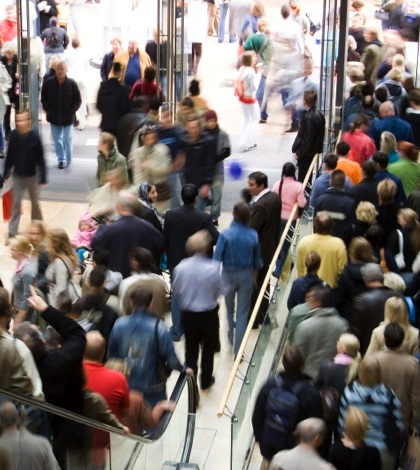A shaky economy and a short shopping season are keeping expectations down, and seasonal hiring is expected to match last year’s numbers
Will 2013 turn out out to be a not-so-merry Christmas for U.S. retailers, another solid but unspectacular shopping season like the past few years have been?
Yes, if the holiday forecasts of two of the country’s major retail organizations end up being true.
The International Council of Shopping Centers in New York is predicting a 3.4 percent increase in sales for November and December, with both shopping-center sales and chain-stores expected to increase during that time.
The National Retail Federation in Washington, D.C., was a little more optimistic in its Christmas forecast: it’s predicting a 3.9 percent increase, to $602.1 billion in sales compared with 2012, when sales nationwide rose 3.5 percent.
Since most retailers expect holiday sales to rise a minimum of three percent every year, based on population growth and other demographic factors, neither of those predictions can be called bold.
Both trade groups are predicting the same holiday retail performance of the past few years, not a return to boom holiday seasons of eight to 10 years ago. That’s not good for the retail industry, much of which needs a strong Christmas season to show a profit for the year.
Still, the overall outlook is far from bleak.
Seasonal hiring, always considered a good indication of how retailers expect to perform during the holidays, is expected to keep pace with last year.
The retail federation is predicting that U.S. retailers will hire between 720,000 and 780,000 seasonal workers this year. If that forecast holds true it would match last year, when about 720,500 workers were hired nationwide for holiday work, a 13 percent increase compared with 2011, according to the federation.
“None of the major retailers are predicting big holiday seasons,” said Michael Niemira, chief economist with the council. “Even Walmart is predicting modest sales growth [between 1.9 and three percent]. We’ll have to wait and see how this plays out.”
The retail federation – which bases most of its predictions on data from the U.S. Department of Commerce – is leaving “room for improvement” over last year in its holiday forecast, while taking a comprehensive look at the state of the economy during the last quarter of 2013, according to a statement.
One area where retail performance is expected to improve substantially this year is online sales. Shop.org, a division of the retail federation that promotes online shopping, predicts that holiday-related Internet sales will increase between 13 and 15 percent this year compared to 2012, to about $82 billion in total sales.
That would be a repeat of last year, when online sales increased 15.5 percent compared with 2011, according to shop.org.
Whether people shop online or at the traditional brick-and-mortar store, the economy will have to remain stable in order for holiday sales to reach even the modest goal of three to four percent growth, according to the retail federation.
“For consumers to turn out this holiday season, we need to see steady improvements in income and job growth, as well as an agreement from Washington that puts an economic recovery first,” said Jack Kleinhenz, the retail federation’s chief economist, in a statement.
The council, a global trade association, made its holiday prediction in late September, seven weeks before Black Friday. That prediction didn’t change during the 16-day shutdown of the federal government and the debate over whether to raise the national debt limit.
Both of those crises were resolved last week, when Congress approved a bill that avoids a debt default and funds the federal government through Jan. 15 of next year.
Had those issues not been resolved before the default deadline passed, the impact on the holiday shopping season might have been devastating.
As of mid-October, 40 percent of U.S. consumers reported that they had already cut back on their spending because of the government shutdown, according a study by ORC International, a market research firm in London.
The survey, which was commissioned by the council and Goldman Sachs, found that 47 percent of consumers with annual incomes of $35,000 or less said they were more likely to cut back their holiday spending because of the government shutdown, compared with 32 percent of those with yearly incomes of $100,000 or more.
Now that the federal government is operating again and able to pay its bills, it remains to be seen whether consumer confidence will be restored quickly enough to preserve even a modest holiday season.
It’s a red flag that four out of ten U.S. consumers said they had cut back on their spending because of the government shutdown, before the shutdown really began, Niemira said.
“I thought that was ominous,” Niemira said. “If the government had stayed shut down, and if the debt limit had not been lifted, the impact on the economy would have been really bad.”
Because the holiday shopping season is shorter this year – Black Friday falls on Nov. 29 – retailers are likely to offer some discounts to make sure that shoppers get their shopping started early, Niemira said.
That will guarantee a good opening weekend, but it could also cut into sales in the middle of December.
“Sometimes I think people make the first weekend a bigger deal than it is,” Niemira said. “Macy’s just announced that they’re going to be open Thanksgiving Day. That’s an interesting move, and I don’t think anyone like Macy’s has done that before, but I don’t know that it will make much difference in their sales.”
Clothing likely will be the most popular gift item this year, as it usually is, followed by electronics, specifically tablets and smart phones, Niemira said.
“Electronics always does well at Christmas, and there are a lot of products in play this year,” he said. “That’s going to create a lot of competitive pressure in that sector. But on the overall, we aren’t overly optimistic like we were two years ago, when we predicted four percent growth.”
The Galleria at Tyler in Riverside has a leg up on most of its competitors heading into the holidays: by Black Friday, the mall will have added three specialty stores and reopened an expanded Foot Locker store, said Christina Riojas, the regional mall’s marketing director.
Galleria at Tyler expects to perform as well during the holidays as the national retail market is expected to perform: it’s predicting a three to 3.5 percent increase in sales compared with the 2012, Riojas said.
“We aren’t seeing a lot of shopping yet, but we still expect to have a good year,” Riojas said. “The government shutdown might have put some fear into people, but we still think we’re going to have a solid year. We should have a good Black Friday and go from there.”
 IE Business Daily Business news for the Inland Empire.
IE Business Daily Business news for the Inland Empire.


